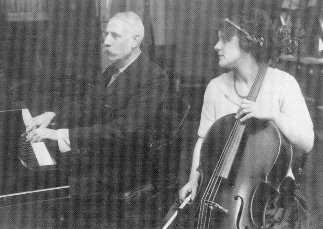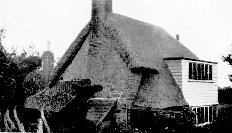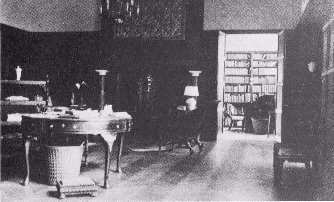|
This tour contains musical excerpts in RealAudio format taken from the Naxos CD
Elgar : Orchestral Works (Naxos 8.554409) and used by courtesy of Naxos Special
Markets. The cello is played by Maria Kliegel, supported by the Royal Philharmonic Orchestra
conducted by Michael Halasz. For fuller details of Naxos recordings, visit the
Naxos UK and Naxos USA websites.
Remember! These excerpts remain subject to normal copyright
controls.
|
Imagine if Hamlet began with the Prince alone on stage, delivering the lines,
"To be or not to be ..." - no explanation, no setting of the scene, just one character
thinking out loud, leaving us to make what we will of what he says. Elgar does the
musical equivalent at the opening of the Cello Concerto, placing the listener in the
middle of things from the work's opening bars.This is not the way concertos are
supposed to begin. Generally there is an extended orchestral introduction, after which
the solo instrument makes a carefully stage-managed first appearance. In Dvorak's
Cello Concerto, for example, the opening orchestral section lasts a full three-and-a-half
minutes.
 |
Beatrice Harrison with cello,
accompanied by Elgar at the piano
|
|
Elgar begins instead with four insistent chords on
the cello that immediately create a sombre mood. They receive a gentle answer from strings,
clarinets and horns, and then the cello becomes more agitated, in a series of rising notes that
seems to promise some emphatic statement. What we hear is something else: the violas launch
into a subdued lament in 9/8 time that was Elgar's original impetus for
the work. He started the concerto just months after the end of the First World War,
and this great elegiac melody is Elgar's lament for all that the war had cost - millions of
lives, and, with them, a way of life. Gently swaying between a half note and a quarter
note as it winds its way through shifting keys, the theme manages to express both the
numbed serenity of grief and the ache within. This main theme is passed from orchestra
to cello and back again, becoming more anguished with each restatement, until it
finally returns on the cello in the same subdued manner in which we heard it first. This
leads to a more animated second theme in 12/8, which begins as a dialogue between
strings and woodwinds. The first theme is heard again, and the movement ends with
three plucked notes on the cello. With its two simple themes that forego any
substantial development, the movement uses one of music's simplest form - the
three-part structure of a song.
 |
| Brinkwells
|
|
The second movement is a brief, pastoral interlude,
perhaps inspired by Brinkwells,
the house overlooking the Sussex downs where Elgar lived much of the
time from 1917 to 1919 and regained the desire to compose. After a brief introduction,
the cello launches into a darting melody that has all the
freedom of birds in flight. The episode is a memory of happier days, whether in Sussex or earlier,
on the Malvern Hills, and its sunshine sets off the darker moods of the other movements.
The third movement's adagio shares the same key, B-flat major, as the andante of the Violin
Concerto, and it breathes the same middle-of-the-night atmosphere. As a young man,
Elgar had been to Leipzig and heard some Schumann, whose work he already knew.
"My ideal!" he wrote to a friend, and, thirty-six years later, Schumannesque echoes
haunt the lovingly-shaped melody of the adagio, where
phrase after phrase follows seamlessly and time seems to stand still.
Until now, the concerto has had little of the musical
dialectic - one musical structure countering another - that occurs in most of Elgar's orchestral
works. But in the fourth movement a musical struggle takes place. If Elgar had captioned his
movements, as many German composers liked to do, he might have described it as "Grief goes
out into the world." The orchestra here is brusque and even swaggering, and the bereaved cello
must make its way in these alien surroundings. The cello tries half-heartedly to join in with the
first theme's assertive mood, then introduces a second
theme and leads the orchestra into digressions of its own. When the first theme returns
on the cellos of the orchestra, it is joined by woodwinds and brass, the trumpets shuddering
aggressively.
Now the cello begins an extended soliloquy that is the concerto's core, just as the cadenza of
the Violin Concerto is the core of that work. First it reprises the movement's first theme in
subdued form, as if its violence has been overcome. Some reconciliation seems about
to occur, but instead, with the orchestra muted, the cello gives full expression to its
grief. The adagio's theme reappears, a moment of consolation, perhaps, and then the
cellist takes up the work's opening chords and makes of them a cry of despair like nothing else in music. The orchestra
returns abruptly and brings the work to a hasty conclusion, in Michael Kennedy's words, "as if too
much had been revealed."
 |
The music room at Severn House,
where Elgar composed much of the concerto
|
|
The concerto is filled with reminders of earlier Elgar. The first theme recalls the 9/8 melody
in one of his first important works, the Serenade for Strings of 1892. The darting
rhythms of the second movement bring echoes of the Introduction and Allegro. And
the spirit of Falstaff can be felt in the finale. Here, however, Elgar employs these
familiar features in a more original and more potent way than ever before - a direction
he would continue in his uncompleted Third Symphony. Anthony Payne's recent
"elaboration" of the sketches for the symphony shows that Elgar was beginning to
pursue this direction further just months before his death in 1934.
Frank Beck
|